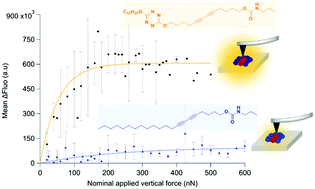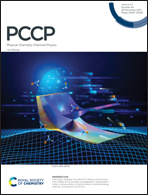Enhanced mechano-responsive fluorescence in polydiacetylene thin films through functionalization with tetrazine dyes: photopolymerization, energy transfer and AFM coupled to fluorescence microscopy studies†
Abstract
The development of mechano-responsive fluorescent materials is essential for the design and construction of reliable and versatile sensors for mechanical stress. Herein, novel energy transfer-based systems with tetrazine fluorophore and a polydiacetylene (PDA) backbone are synthesized and studied comparatively to a simple polydiacetylene in the form of thin films. Their photopolymerization properties, energy transfer efficiencies and fluorescent response to nanoscale mechanical stimulation are assessed. It is pointed out that the self-assembling group on the PDA chain influences the geometrical arrangement of the chains and the film morphology and, as a consequence, the efficiency and kinetics of polymerization and the energy transfer efficiency. Moreover, we show that the strategy of introducing tetrazine fluorophore provides a new effective route of improving force detectability by fluorescence using polydiacetylenes as mechano-responsive units.



 Please wait while we load your content...
Please wait while we load your content...